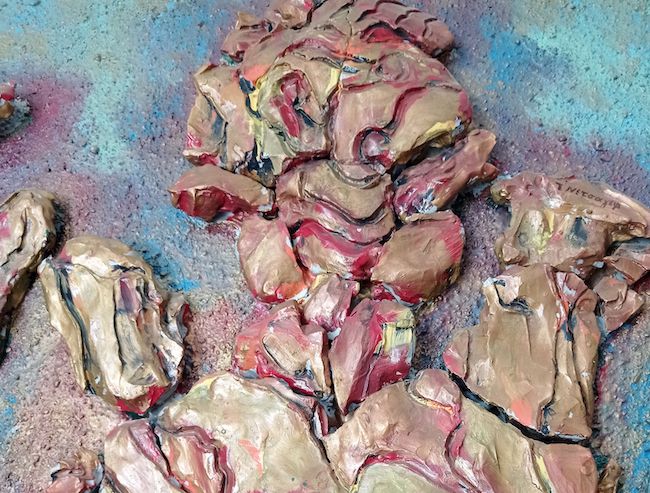Il linguaggio espressivo degli artisti contemporanei assume connotazioni del tutto personali in virtù dell’eredità culturale lasciata dai grandi maestri del Novecento che hanno avuto il coraggio di sperimentare e addentrarsi nello studio di tecniche completamente nuove, di rivoluzioni espressive che hanno costruito la base da cui molti creativi di questo secolo sono partiti per dar vita al proprio stile rielaborando quelle precedenti linee guida. La protagonista di oggi si muove su due temi principali che narra attraverso un linguaggio espressivo di grande carattere in grado di coinvolgere sia per il rilievo e l’interazione con lo spazio circostante, sia per l’intensità emozionale che contraddistingue le sue opere.
Il mondo delle emozioni ha cominciato a diventare rilevante dal punto di vista artistico nel momento in cui la priorità della rappresentazione estetica, dell’aderenza alla realtà osservata e della perfezione delle forme cominciò a perdere smalto e senso perché il progredire della società, l’esigenza rivoluzionaria della classe popolare a reclamare maggiori diritti, l’instabilità politica dell’Europa sfociata di lì a poco con il primo conflitto mondiale, rendevano anacronistica una celebrazione del bel vivere borghese, della superficialità e del formalismo di uno stile di vita che era completamente distaccato dalla direzione verso cui andava il progresso con tutti i cambiamenti che portava con sé. In quella delicata fase molti artisti vollero ribellarsi alla mancanza di spessore emozionale delle regole espressive del periodo appena precedente, come nel caso del Realismo e dell’Impressionismo, cercando un modo per permettere alle sensazioni, alle profondità, ai timori, alle angosce, agli stati d’animo anche turbolenti, di fuoriuscire liberandosi da ogni regola che non avrebbe fatto altro che limitarne l’impeto comunicativo. L’Espressionismo, questo il nome della nuova corrente in cui il sentire interiore era prioritario sull’estetica, sulla perfezione esecutiva, sulla riproduzione dell’osservato, divenne preponderante soprattutto tra quei creativi per i quali non aveva senso separare il turbinio dell’anima dall’opera d’arte che doveva parlare alle corde profonde dell’osservatore; per raggiungere questo risultato dunque bisognava distaccarsi dalla bellezza, dalla piacevolezza visiva perché sia le immagini che la gamma cromatica dovevano accordarsi all’intenzione emozionale, al sentire profondo dell’esecutore dell’opera che non temeva di mettere a nudo le proprie paure, le ansie e la disperazione che appartenevano anche alle persone comuni. Qualche decennio dopo, intorno alla metà degli anni Cinquanta, negli Stati Uniti Jackson Pollock diede vita a un movimento in cui le linee guida dell’Espressionismo si associavano all’Astrattismo, sottolineando ancora una volta quanto importante fosse per gli artisti lasciarsi andare e liberare quel mondo interiore che doveva fuoriuscire in maniera spontanea, senza alcun filtro da parte della razionalità, e interpretata attraverso le emozioni. Quel movimento prese il nome di Espressionismo Astratto e determinò un giro di boa importante nel panorama artistico di tutto il mondo perché affermò con forza il distacco dal rigore dell’Astrattismo tradizionale in cui l’attenzione era concentrata sul gesto plastico privato di ogni soggettività dell’autore, e anche da uno schematismo, una rigidità che non coinvolgeva l’osservatore perché non ne toccava le corde emotive.
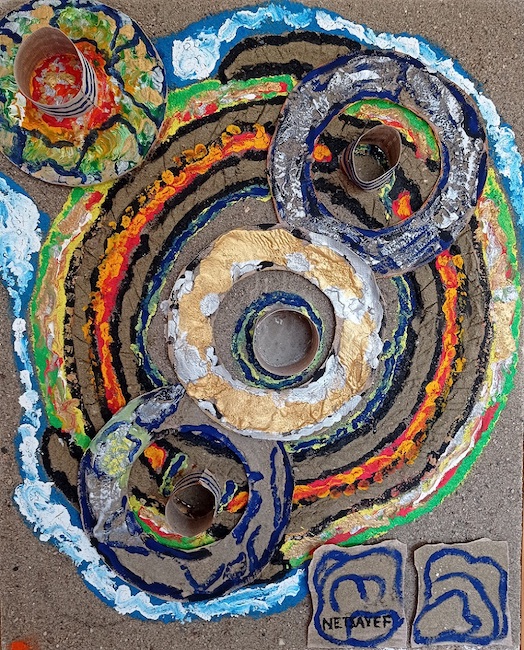
L’artista greca Elena Netsayef utilizza entrambi gli stili, l’Espressionismo e l’Espressionismo Astratto in base alla narrazione che intende affidare all’opera, secondo quale dei due temi per lei fondamentali e imprescindibili dall’atto esecutivo desidera far fuoriuscire; la sua ricerca infatti è prima filosofica e solo in un secondo tempo si manifesta sulla tela, dopo che la riflessione e l’ascolto delle energie che la circondano trovano una soluzione, una risposta la quale poi deve essere espressa sotto forma di colori, di materia, di associazione tra mente e anima che costituisce una continua ricerca da parte dell’essere umano il quale non sempre riesce a stare in equilibrio tra due forze apparentemente opposte.
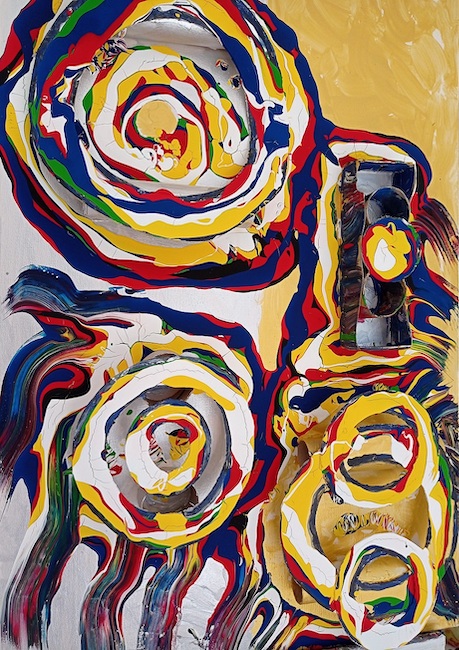
Elena Netsayef tenta invece di unire l’approccio più razionale, logico, orientato a cercare le risposte alle grandi domande dell’umanità, e quello invece più istintivo, spontaneo, naturale che scaturisce quando a seguito della riflessione si scopre l’importanza di porsi in maniera empatica nei confronti dell’altro quanto di tutto ciò che circonda l’individuo, anche quando costituisce un mistero mai svelato.
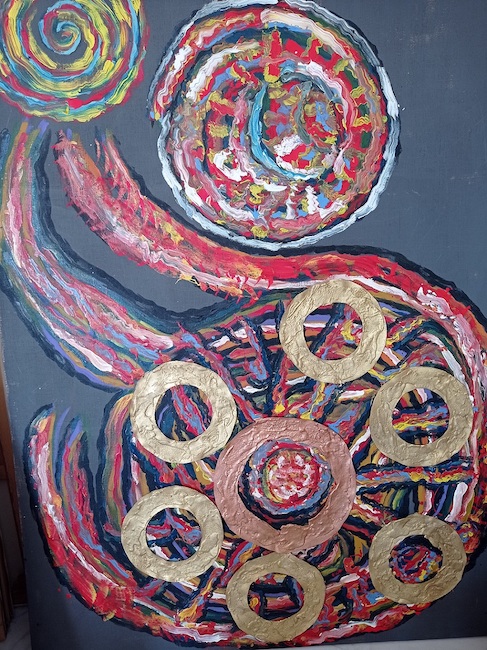
L’Universo e il rapporto tra uomo e donna, cari all’artista che dà vita a opere intense, arricchite da un rilievo materico sopra il quale vengono posti numerosi strati di colore, quasi come se il suggerimento fosse quello di spingersi ad andare sotto quelle cronicizzazioni di materia perché è lì, dopo essere giunti all’essenza che si può trovare la risposta alle proprie domande.
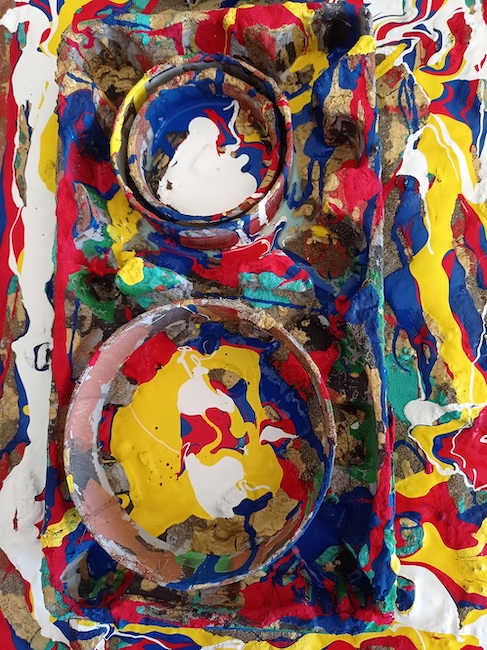
Questa caratteristica di dare consistenza tridimensionale alle opere, costituisce un tratto distintivo di Elena Netsayef perché sente il bisogno di entrare in contatto con lo spazio circostante la tela, rendendo il dipinto talmente sporgente e voluminoso da avvolgere con la sua forza espressiva il fruitore che non riesce a sottrarsi al magnetismo che le opere esercitano.
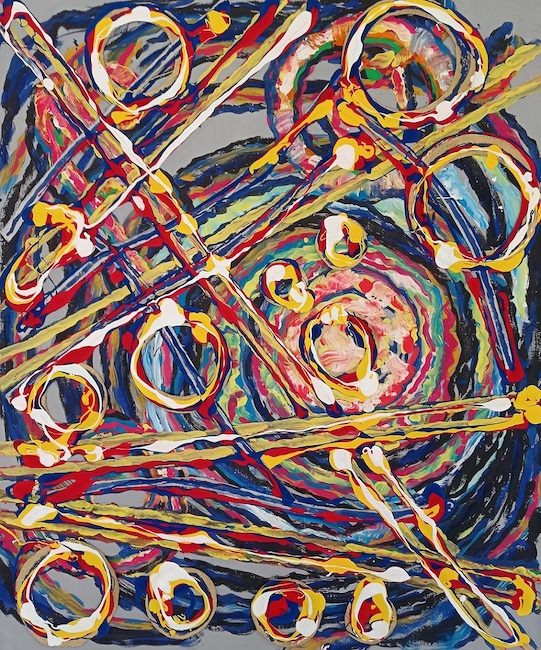
I vortici sono emozioni, sono circostanze energetiche che si susseguono concatenandosi e che sembrano dialogare con l’interiorità, stimolando l’apprendimento di inediti aspetti sulla base di un punto di vista diverso, nuovo perché spinto dall’ascolto nei confronti di ciò che si nasconde oltre il visibile, di quella silenziosa richiesta di evoluzione che però spesso non coincide con la capacità dell’individuo di riuscire a farlo; è una connessione superiore quella a cui anela la Netsayef, quella che vorrebbe suggerire all’osservatore di quelle onde concentriche di energia e di consapevolezza in virtù delle quali sa di doversi immergere se desidera che l’esperienza visiva di trasformi in qualcosa di più forte e profondo, in un cambiamento dell’approccio alla quotidianità da non attraversare più in maniera inconsapevole bensì con la certezza che tutto abbia un senso, che tutto accada per renderlo cosciente di quanto le energie sottili siano in continuo movimento e in ascolto del singolo per aiutarlo nel suo cammino. Quando si sposta sul tema dei rapporti tra uomo e donna invece, Elena Netsayef sceglie l’Espressionismo, torna alla figurazione pur interpretata dal suo sentire, dal suo desiderio di andare a indagare su un legame spesso in contrasto, spesso in disaccordo tanto quanto altrettanto di frequente incapace di distacco, con la consapevolezza da parte di entrambi di non poter vivere senza l’altro perché come nello Yin e nello Yang esiste un processo di completamento reciproco che rende impossibile proseguire in solitaria.
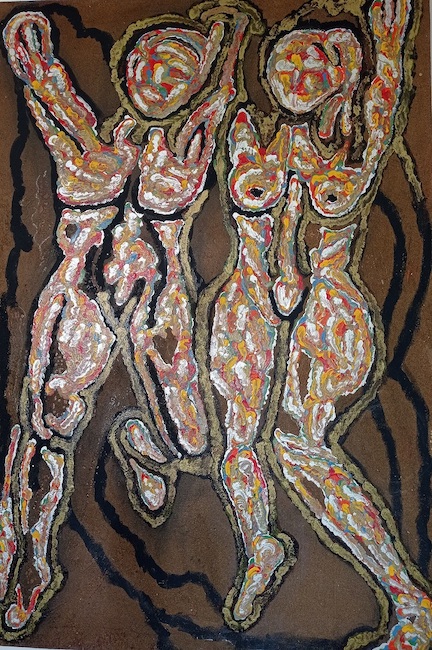
In questa serie di opere l’artista descrive i personaggi, un lui e una lei che rappresentano il genere maschile e il genere femminile, senza veli perché in fondo è solo quando le due interiorità riescono a mettersi a nudo che si scoprono le rispettive debolezze così come le effettive essenze in virtù delle quali dialogare a un livello più profondo, più intenso. Elena Netsayef sembra suggerire che solo accogliendo le rispettive diversità si possono scoprire le più sottili similitudini, solo attraverso un attento e aperto ascolto, è possibile comprendere quanto importante sia la congiunzione di due opposti che però hanno bisogno l’uno dell’altra per migliorarsi, crescere, salire verso un livello superiore grazie proprio alla consapevolezza dei limiti che si scoprono solo raffrontandosi con un opposto, che non deve mai essere considerato un antagonista, le cui caratteristiche differenti si incastrano perfettamente dando vita a un’unione in cui nessuno dei due prevale bensì è necessario all’altro per dare compimento alla propria vita e alla propria crescita evolutiva.
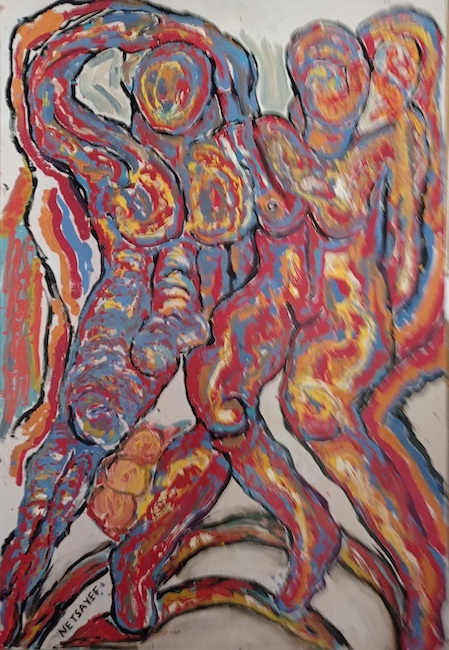
La parte maschile che è dentro ogni donna trova riposo quando incontra quell’uno in grado di incarnare in pieno l’ideale verso cui ciascuno tende e viceversa la parte femminile dentro ogni uomo si ritrae non appena realizza di aver incontrato la donna che corrisponde al suo sogno. Elena Netsayef ha studiato alla Scuola di Arti Decorative Doxiad di Kiev e poi all’Accademia di Belle Arti di Roma, dove ha avuto modo di studiare con importanti maestri del Novecento come Franco Gentilini, Renato Guttuso e Nino Maccari; ha al suo attivo dieci mostre personali e nove collettive in Francia, Grecia, Italia e Russia dove è sempre stata notata per la sua originalità espressiva.
HELENA NETSAYEF-CONTATTI
Email: elena.netsayef@gmail.com
Facebook: https://www.facebook.com/profile.php?id=100015648882106
Instagram: https://www.instagram.com/netsayef/
Elena Netsayef’s Material Expressionism, between abstraction and figuration to wonder about the energies of the universe and the relationship between man and woman
The expressive language of contemporary artists takes on very personal connotations by virtue of the cultural heritage left by the great masters of the twentieth century who had the courage to experiment and delve into the study of completely new techniques, expressive revolutions that built the basis from which many creatives of this century started to create their own style, reworking those previous guidelines. Today’s protagonist moves on two main themes that she narrates through an expressive language of great character capable of involving both for the relief and interaction with the surrounding space, and for the emotional intensity that distinguishes her artworks.
The world of emotions began to become relevant from an artistic point of view at a time when the priority of aesthetic representation, of adherence to observed reality and of perfection of form began to lose focus and meaning because the progress of society, the revolutionary need of the working class to demand greater rights, the political instability of Europe, which soon led to the First World War, made it anachronistic to celebrate the good life of the bourgeoisie, the superficiality and formalism of a lifestyle that was completely detached from the direction in which progress was heading with all the changes it brought with it. In that delicate phase many artists wanted to rebel against the lack of emotional depth of the expressive rules of the period just before, as in the case of Realism and Impressionism, looking for a way to allow feelings, depths, fears, anxieties, even turbulent moods, to escape by freeing themselves from any rule that would only limit their communicative impetus. Expressionism, the name of the new movement in which inner feelings took precedence over aesthetics, perfection of execution and the reproduction of what was observed, became predominant, especially among those creative artists for whom it made no sense to separate the whirlwind of the soul from the work of art, which had to speak to the deepest chords of the observer; in order to achieve this result, it was necessary to detach oneself from beauty, from visual pleasure, because both the images and the range of colours had to be in tune with the emotional intention, with the profound feelings of the artist who was not afraid to lay bare his fears, anxieties and despair, which also belonged to ordinary people. A few decades later, in the mid-1950s, Jackson Pollock gave birth to a movement in the United States in which the guidelines of Expressionism were associated with Abstractionism, underlining once again how important it was for artists to let go and free their inner world, which had to come out spontaneously, without any filter from rationality, and interpreted through emotions.
That movement took the name of Abstract Expressionism and marked an important turning point in the artistic panorama all over the world because it strongly affirmed the detachment from the rigour of traditional Abstractionism in which attention was concentrated on the plastic gesture deprived of any subjectivity of the author, and also from a schematism, a rigidity that did not involve the observer because it did not touch his emotional chords. The Greek artist Elena Netsayef uses both styles, Expressionism and Abstract Expressionism, depending on the narrative she wishes to entrust to the canvas, according to which of the two themes she considers fundamental and inseparable from the act of execution she wishes to bring out; in fact, her research is first philosophical and only later does it manifest itself on the canvas, after that reflection and listening to the energies which surround her find a solution, an answer that must then be expressed in the form of colours, matter, the association between mind and soul which constitutes a continuous search of the human being who is not always able to balance between two apparently opposing forces. Elena Netsayef attempts to combine the more rational, logical approach, oriented towards finding answers to the great questions of humanity, with the more instinctive, spontaneous, natural approach that arises when, after reflection, one discovers the importance of empathising with others and with everything that surrounds the individual, even when it constitutes a mystery that is never revealed. The Universe and the relationship between man and woman, these are the two themes so dear to the artist, who creates intense artworks, enriched by a material relief where numerous layers of colour are placed, almost as if the suggestion was to go underneath those chronicles of matter because it is there, after having reached the essence, that one can find the answer to one’s questions. This characteristic of giving three-dimensional consistency to the paintings is a distinctive feature of Elena Netsayef’s work because she feels the need to come into contact with the space surrounding the canvas, making the painting so protruding and voluminous that it envelops the viewer with its expressive force, and the viewer cannot escape the magnetism that the works exert. The vortices are emotions, they are energetic circumstances that follow one another and seem to dialogue with the interiority, stimulating the learning of new aspects on the basis of a different point of view, new because driven by listening to what is hidden beyond the visible, to that silent request for evolution which, however, often does not coincide with the individual’s ability to succeed in doing so; it is a higher connection that Netsayef yearns for, one that she would like to suggest to the observer of those concentric waves of energy and awareness in virtue of which she knows she must immerse herself if she wants the visual experience to be transformed into something stronger and deeper, into a change in the approach to everyday life that is no longer to be crossed unconsciously but with the certainty that everything has a meaning, that everything happens to make her aware of how subtle energies are in continuous movement and listening to the individual to help him on his way.
On the other hand, when she moves on to the theme of the relationship between man and woman, Elena Netsayef chooses Expressionism, returning to figuration, though interpreted by her feelings, her desire to investigate a bond that is often in contrast, often in disagreement as much as it is frequently incapable of detachment, with the awareness on the part of both that they cannot live without the other because, as in Yin and Yang, there is a process of mutual completion that makes it impossible to go on alone. In this series of paintings, the artist describes the characters, a he and a she who represent the male and female genders, without any veils, because after all, it is only when the two inner selves manage to lay themselves bare that their respective weaknesses are discovered, as well as the actual essences by virtue of which they can dialogue on a deeper, more intense level. Elena Netsayef seems to be suggesting that it is only by welcoming their respective diversities that one can discover the most subtle similarities, only through careful and open listening is it possible to understand how important the conjunction of two opposites is that however need each other to improve, to grow, to rise to a higher level, thanks to the awareness of the limits that can only be discovered by comparing themselves with an opposite, who must never be considered an antagonist, whose different characteristics fit perfectly together, giving life to a union in which neither of the two prevails but is necessary to complete life and evolutionary growth. The masculine part inside every woman finds rest when she meets the one who fully embodies the ideal towards which each one tends, and vice versa the feminine part inside every man retreats as soon as he realises he has met the woman who corresponds to his dream. Elena Netsayef studied at the Doxiad School of Decorative Arts in Kiev and then at the Academy of Fine Arts in Rome, where she had the opportunity to study with important masters of the twentieth century such as Franco Gentilini, Renato Guttuso and Nino Maccari; she has had ten solo and nine group exhibitions in France, Greece, Italy and Russia, where she has always been noted for her expressive originality.


